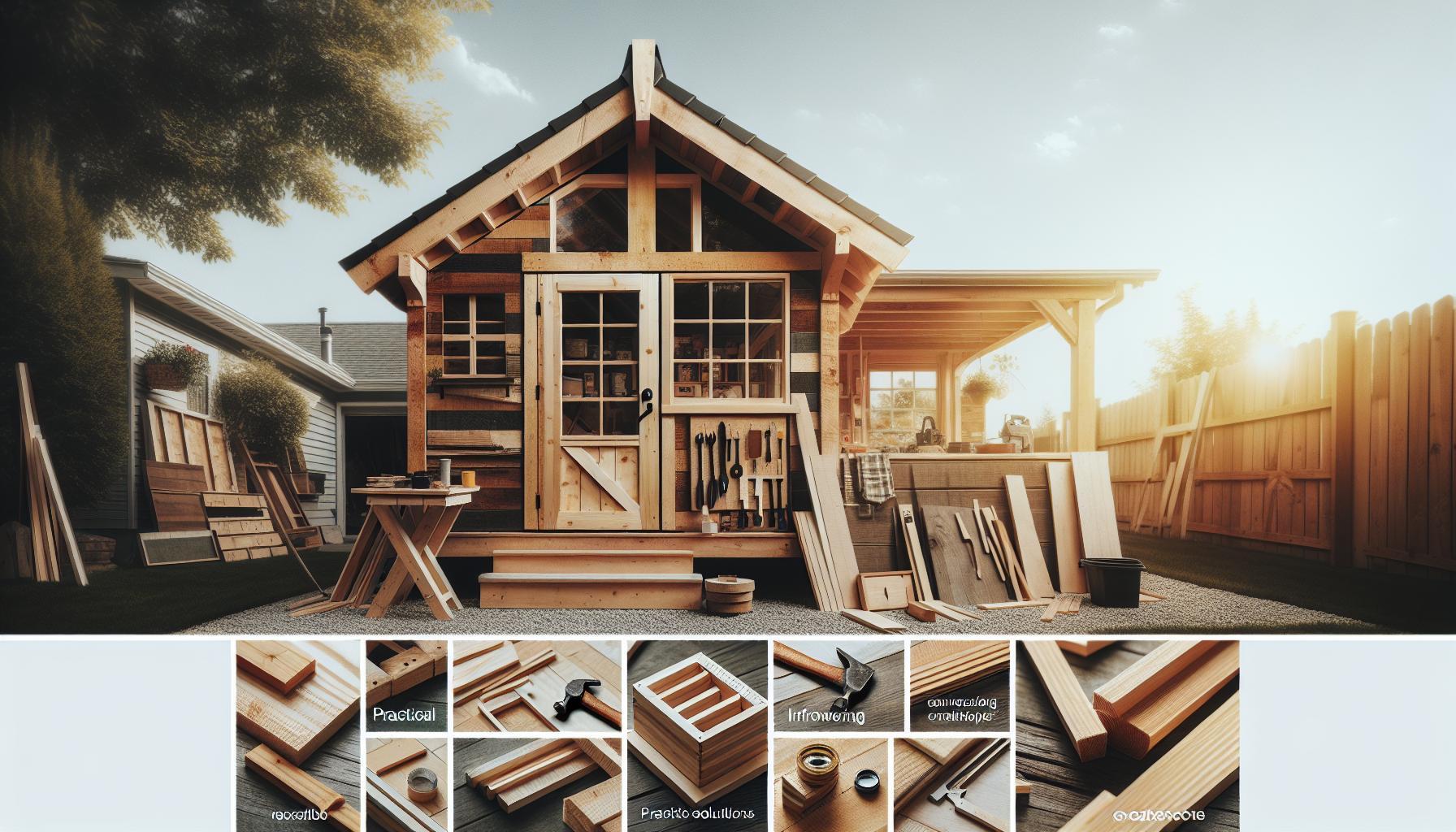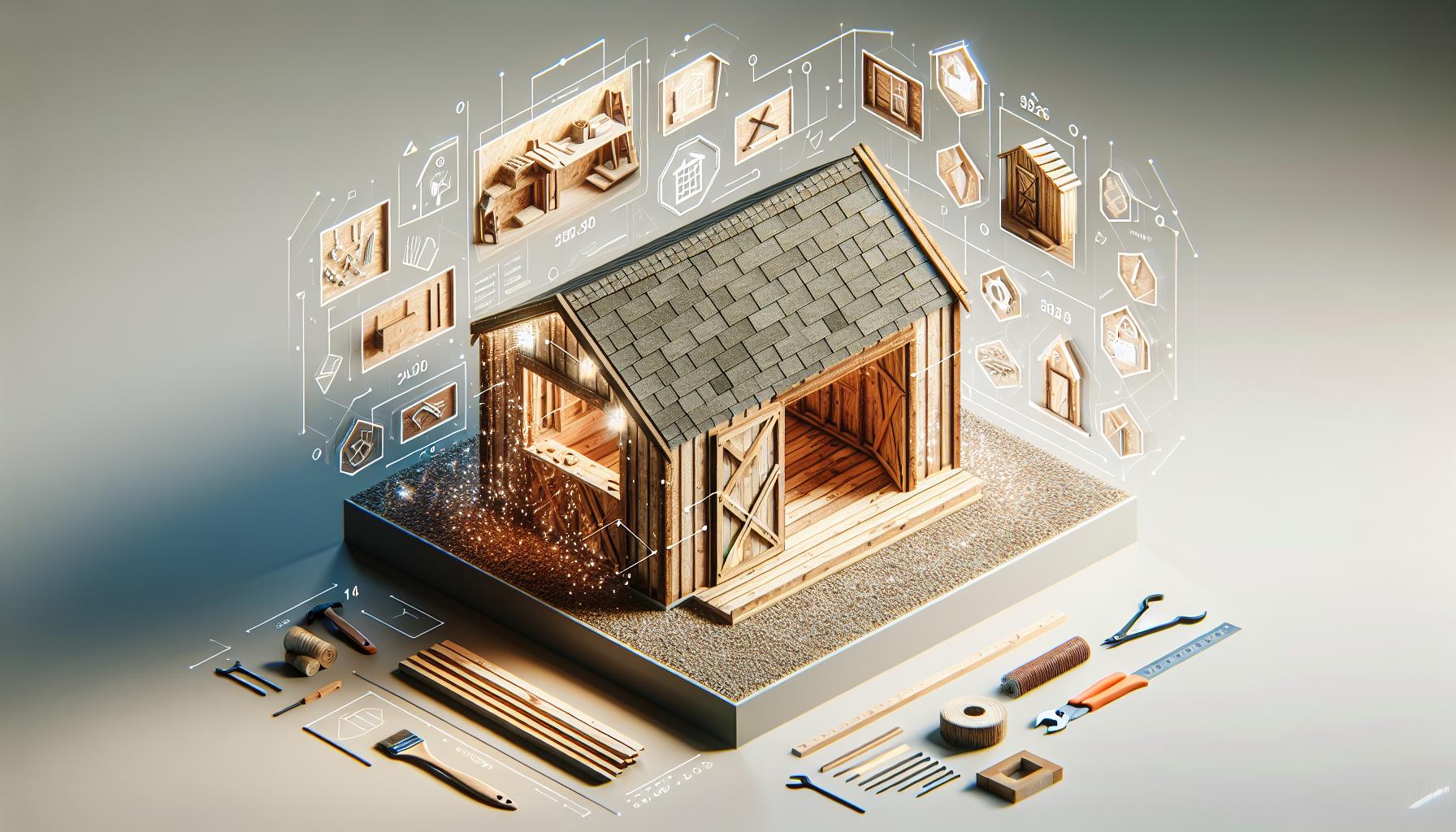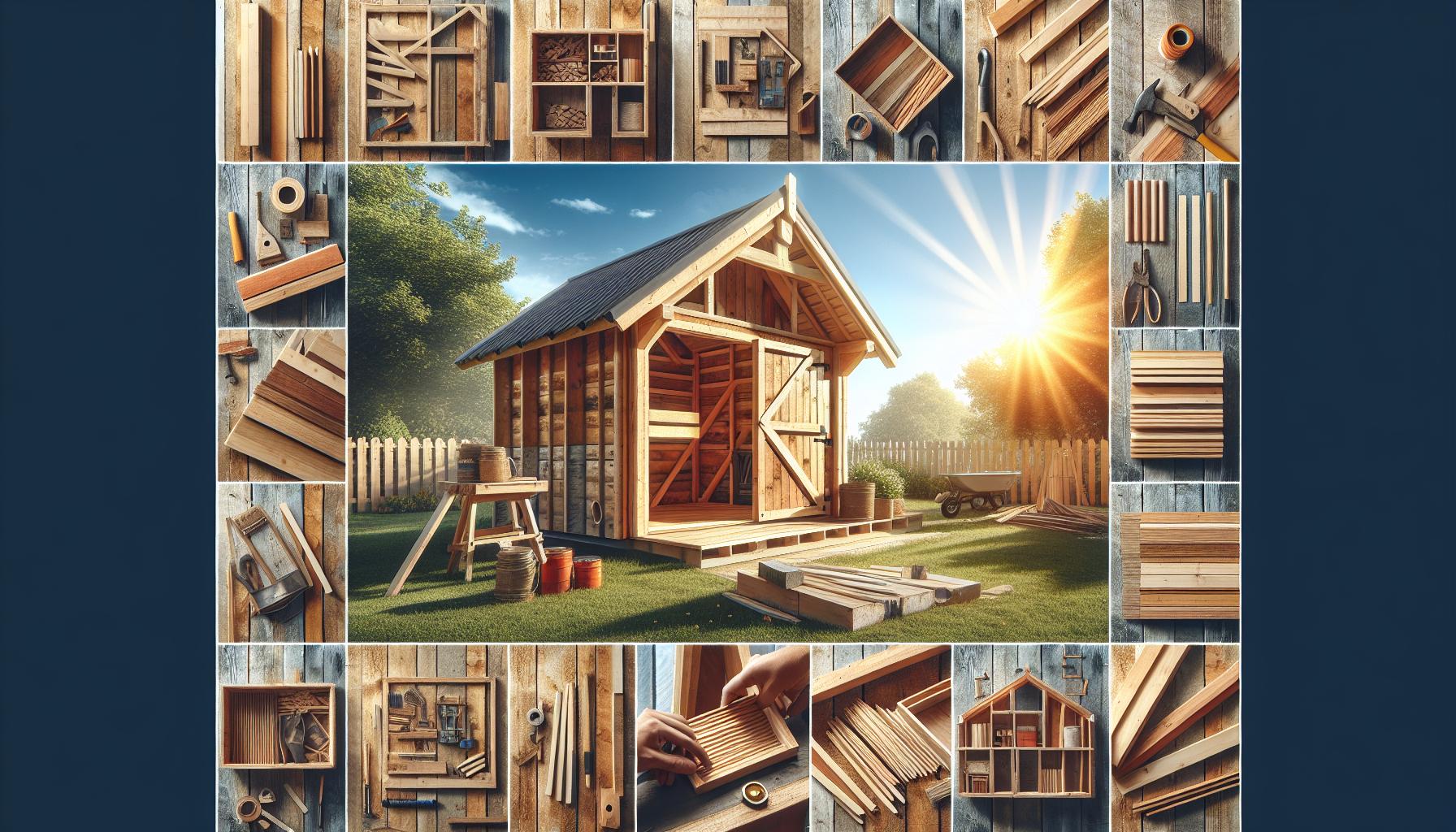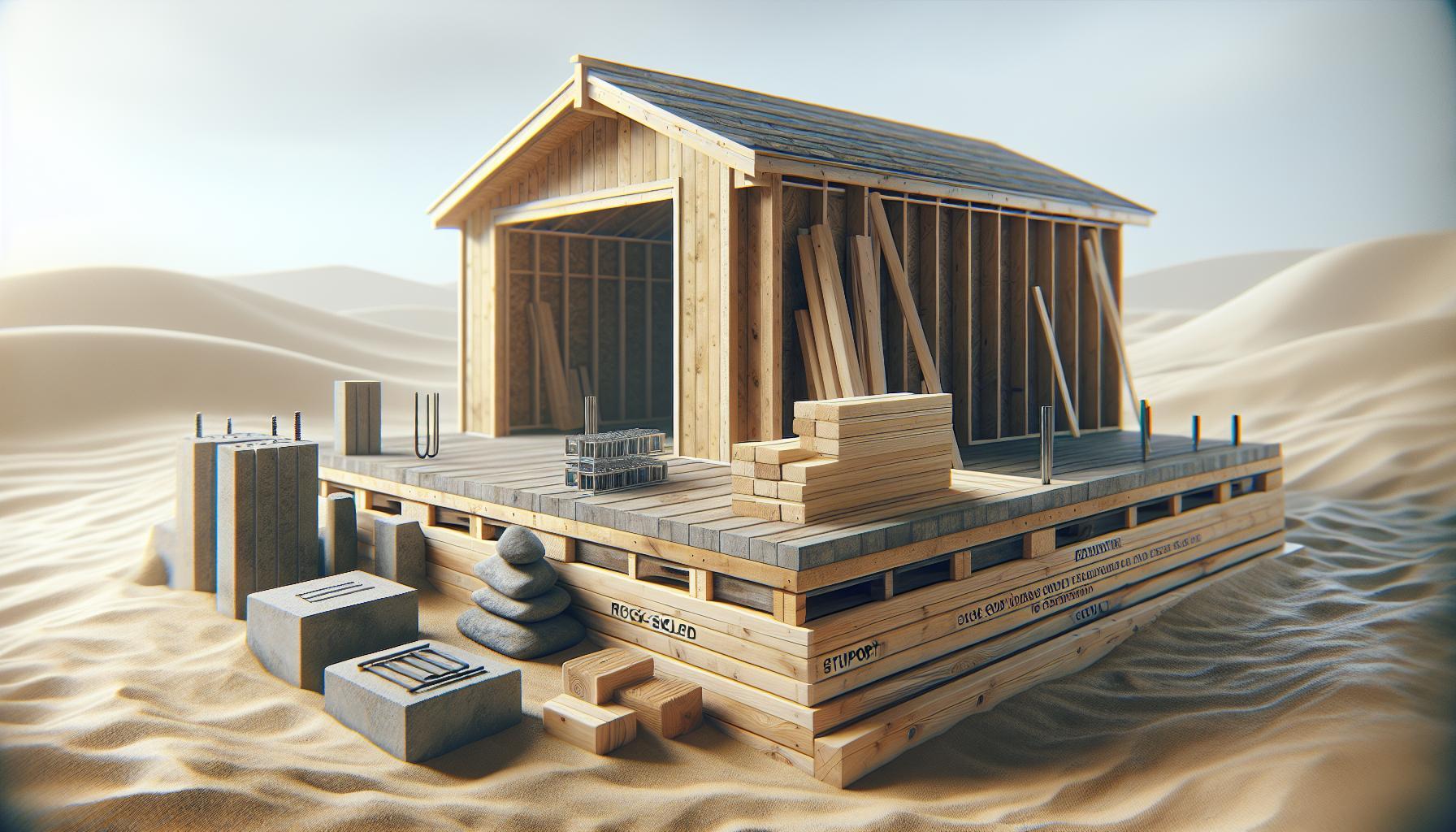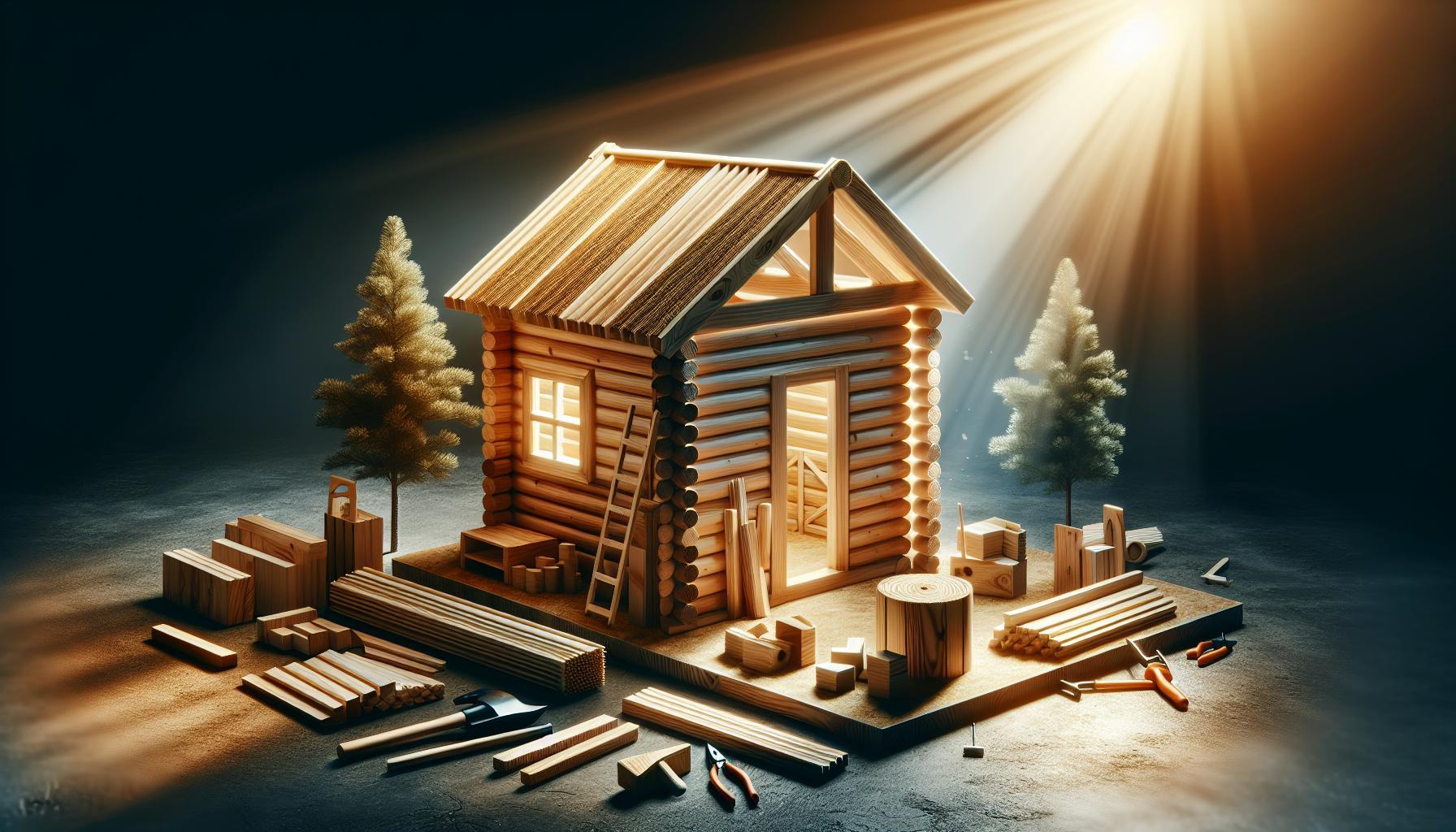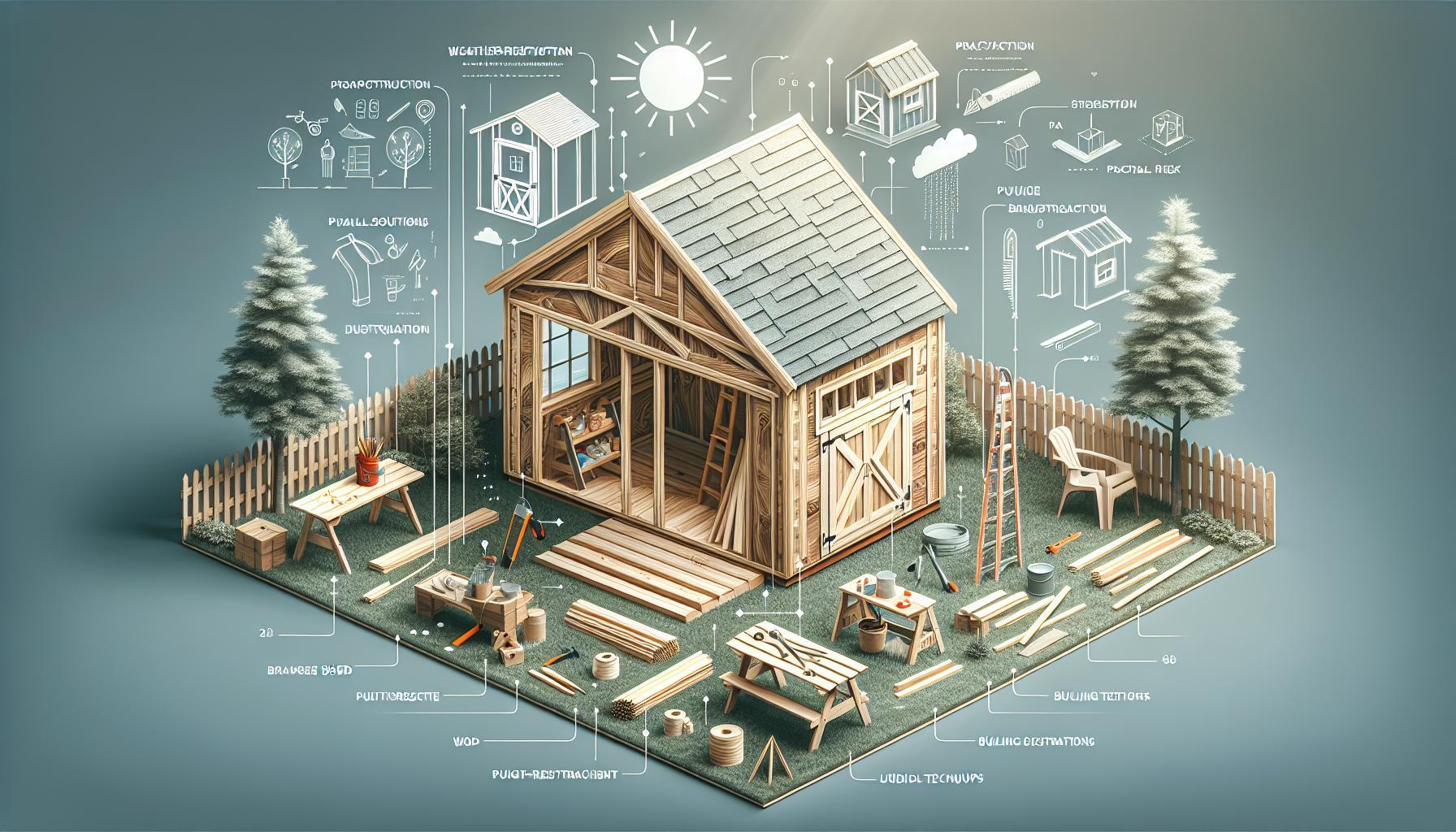Struggling with clutter in your outdoor space? Building a backyard shed is the perfect solution to reclaim your yard while enhancing its functionality and aesthetics. This guide walks you through the essentials of designing and constructing a personalized storage haven, ensuring your tools and equipment have a stylish home.Let’s get started!
Understanding your Backyard Shed Needs: Assessing Space and Functionality
Evaluating your backyard shed needs is not just a practical consideration; it’s the first step towards creating a functional and stylish storage solution that enhances your outdoor space. Before jumping into the design and construction phases of your project, it’s essential to understand your unique requirements, including the available space, desired functionality, and how the shed will complement your property.
Assessing Your Available Space
Begin by measuring the area where you plan to place your shed. Proper measurements will help you avoid the common pitfall of either overestimating your space or trying to fit a structure that is too large. Consider the following factors:
- Physical Dimensions: Measure the width, depth, and height of your designated area. Aim for a shed that fits comfortably without overcrowding your yard.
- Access Points: Ensure there is enough space for walking around the shed and for accessing entry points like doors and windows.
- Environmental Elements: Observe sun exposure, wind patterns, and potential drainage issues that might affect your shed’s location.
Utilizing a simple sketch or digital design software can help visualize the space and how the shed will fit within the overall landscape.
Determining Functionality
Once you have your space defined, the next step is to clearly identify what functions your shed will serve. Will it be a storage area for gardening tools, a workshop for DIY projects, or even a space for outdoor hobbies? Your shed’s purpose will substantially influence its design, size, and features.
| Function | Suggested Size | Essential Features |
|---|---|---|
| Garden Tool Storage | 6’x8′ | Shelves, Hooks, Ventilation |
| Workshop | 10’x12′ | Workbenches, Electrical Outlets, Lighting |
| Hobby Space | 8’x10′ | Windows for Natural Light, Storage Solutions, Seating Area |
| Outdoor Equipment | 10’x10′ | Double Doors, Ramps, Shelving Units |
Tip: Each function could require different configurations and layouts. For instance, if your primary need is for a workshop, prioritize space for work surfaces and tools, while a garden tool shed may benefit more from vertical storage and organization options.
By thoughtfully assessing both your available space and desired functionality, you set the groundwork for efficiently creating your dream storage solution. This approach ensures that every square foot of your new shed serves a purpose and contributes to a well-organized and aesthetically appealing outdoor environment.
Choosing the right Materials: A Guide to Durable and Affordable Options
When embarking on the project of creating your ideal storage solution, the selection of materials is crucial for achieving both durability and cost-effectiveness.The right materials can greatly extend the lifespan of your shed while ensuring it remains economically feasible. This guide will delve into various materials that strike an optimal balance between affordability and resilience, helping you make informed decisions throughout the shed-building process.
Essential Materials to Consider
There are numerous materials available for your backyard shed, each with its own set of advantages and drawbacks. Here’s a breakdown of popular options to help you determine which aligns best with your vision and budget:
- Wood: A classic choice for shed construction, wood offers versatility and natural aesthetics. Consider using pressure-treated lumber or cedar for superior resistance to decay and insects. However, keep in mind that wood requires regular maintenance, including sealing and painting, to prevent wear over time.
- Metal: Steel or aluminum siding provides unmatched durability and often comes with warranties. Metal sheds are resistant to pests and provide excellent security. Though, be aware of potential rusting; opting for galvanized steel is advisable for longevity.
- Vinyl: Vinyl sheds are becoming increasingly popular due to their low maintenance requirements and resistance to rot,rust,and fading. They are often more expensive upfront but can save money in the long run through minimal upkeep.
- OSB or Plywood: Oriented strand Board (OSB) and plywood are affordable choices for your shed’s structural components. They provide adequate strength and support but should be properly sealed to shield against moisture.
Cost Comparison of Common Materials
To assist you in budgeting for your shed, here is a simple cost comparison of various materials typically used in shed construction. understanding these costs will provide a clearer picture of what you might expect to spend.
| Material | Estimated Cost per Square Foot | Durability | Maintenance Requirements |
|---|---|---|---|
| Wood (Pressure-Treated) | $2.50 – $6.00 | Moderate | Regular sealing & painting |
| Metal (Galvanized Steel) | $4.00 – $8.00 | High | Occasional rust treatment |
| Vinyl | $5.50 – $10.00 | Very High | Minimal |
| OSB | $1.50 – $3.50 | Moderate | Moisture protection needed |
By assessing your options carefully and considering the long-term implications of your material choices, you can ensure that your backyard shed is both durable and affordable. Each choice carries different costs and maintenance needs, so tailor your selections to best fit your lifestyle and storage needs. When done thoughtfully, the process of building a shed can not onyl enhance your backyard but become a rewarding DIY project as well.
Crafting a solid Plan: Designing Your Shed with Purpose
Designing a shed isn’t merely about picking a style; it’s about crafting a functional space that meets your specific needs while harmonizing with your backyard. A well-thought-out plan is crucial to ensure that your shed serves its purpose efficiently, whether for storage, a workshop, or a garden haven. the process begins with asking yourself some essential questions: What will you primarily use your shed for? How much space do you really need? Determining your shed’s purpose will guide your design choices and ensure that the final result aligns perfectly with your vision.
Identify Your Needs
Once you clarify the main purpose of your shed, creating a list of what you want to include will help you visualize the space. Consider the following factors:
- Storage Requirements: Assess what items you’ll store—gardening tools, bicycles, seasonal decorations.A thorough inventory helps avoid last-minute adjustments.
- Space Optimization: Evaluate whether shelving, hooks, or modular storage systems can maximize vertical and horizontal space.
- Accessibility: Think about the best placement of doors and windows for easy access and natural light.
Choose the right Design and Layout
Your shed’s layout should facilitate the activities you plan to carry out inside. For example, if you intend to use the shed as a workshop, ensure there is enough space for a workbench, tool storage, and adequate lighting. Sketch a basic floor plan that includes various zones,such as a tool area,storage sections,and perhaps a workspace. Refer to platforms offering free shed plans for inspiration and structural guidance that accommodate a range of designs and budgets.
| Key Design Element | Considerations |
|---|---|
| Size | Based on purpose; remember local building codes. |
| Style | Choose gable, lean-to, or custom, depending on aesthetics and function. |
| Materials | Durability vs. cost; wood, metal, or vinyl siding options. |
| Foundation | Ensure level surface; consider skids, concrete blocks, or a slab. |
With these foundational elements defined, you’re well on your way to creating a shed that not only meets your practical storage needs but also enhances your backyard’s functionality and style. The goal is to implement your vision practically so you can enjoy the results for years to come. Whether you’re following a plan or designing from scratch,remember to keep your specific goals in mind during the building process.
Step-by-Step Construction: From Foundation to Finishing Touches
Building a backyard shed is an exciting project that not only provides essential storage but also enhances your outdoor space. Once you visualize your ideal shed, it’s time to break the construction process into manageable steps—from laying a solid foundation to adding those final charming touches that make it truly yours. Let’s dive into the essential phases of your shed construction.
Starting with a Solid Foundation
The foundation is the backbone of your shed—it ensures durability and stability for years to come. Begin by selecting an appropriate site, ideally a level area that receives adequate drainage. Here are a few foundation options to consider:
- Concrete Slab: Provides a robust, permanent base, ideal for larger sheds.
- Concrete Blocks: Offers versatility and ease of construction, best for smaller structures.
- Wooden Beams: A cost-effective option if you prefer a simpler, lightweight solution.
Ensure that the foundation is square by measuring diagonally across the corners to check for equal distances; this will make assembling the shed’s frame much easier.
Building the Frame and Walls
With your foundation in place, it’s time to construct the frame and walls. Typically, a wooden frame will suffice, providing strength while being easy to work with. Follow these steps to get started:
- Cut the Lumber: Depending on your shed’s design, cut your framing lumber to length.
- Assemble the Frame: Use screws to assemble the vertical and horizontal framing into rectangles that will act as your walls.
- Raise the Walls: Carefully lift and secure each wall frame to the foundation, ensuring they are plumb using a level.
- Nail Together: Once the walls are secured, connect them at the corners for additional stability.
Here’s a simple table to help visualize the lumber sizes you might need for a standard shed:
| Lumber Type | Dimensions | Quantity |
|---|---|---|
| Wall Framing | 2×4 inches | 10-15 pieces |
| Floor Joists | 2×6 inches | 5-10 pieces |
| Roof Rafters | 2×6 inches | 8-10 pieces |
Roofing and Siding: The Next Layers
Now that you have sturdy walls, it’s time to cover them! Installing the roof is critical for protecting your shed from the elements. Begin with the following steps:
- Install Roof Rafters: Space them appropriately according to your roof style—whether gable or lean-to.
- Lay Roofing Material: Use plywood sheathing followed by shingles or metal sheets for waterproofing.
- Add Siding: Choose your siding material—wood, vinyl, or metal—and secure it to the walls, ensuring to start from the bottom and work your way up to shed water.
Finishing Touches for a Personal Flare
Once the structure is complete, it’s time to enhance its aesthetic appeal and functionality. Consider these final elements:
- Paint or Stain: protect the wood and add color to match your home or garden.
- Windows: Add natural lighting; vinyl or glass options are popular.
- Doors: Opt for single or double doors based on size, incorporating handles and locks for security.
- Storage Solutions: Shelving, hooks, and bins can maximize space and organization.
By following these detailed steps, you’ll not only learn how to build a backyard shed but also create a personalized storage solution that complements your home and meets your needs. Enjoy the process and take pride in your DIY achievement!
Essential Tools and Safety Tips for the DIY Shed Builder
Building your own backyard shed is an exciting venture that unlocks numerous possibilities for extra storage, workspace, or even a cozy getaway! However, embarking on this DIY project requires more than just enthusiasm; it calls for the right tools and adherence to safety protocols to ensure a successful outcome.Equipping yourself with the essential tools,along with a solid understanding of safety practices,will pave your way to creating a remarkable storage solution that meets your needs.
Essential Tools for Shed Construction
Before diving into the building process, it’s crucial to gather the necessary instruments that will assist you at every stage.Here’s a handy list of essential tools you’ll need for constructing your backyard shed:
- Measuring Tape: Accuracy is key,so invest in a sturdy measuring tape to ensure perfect dimensions.
- Circular Saw: This versatile tool is indispensable for cutting lumber and plywood for your shed structure.
- drill/Driver: A power drill simplifies the task of making holes and driving screws, essential for assembling your shed.
- Level: To ensure that your shed sits evenly, a level will help you achieve a straight and balanced build.
- Safety Gear: Don’t forget your gloves, goggles, and ear protection to safeguard yourself while working.
Safety Tips to Keep in mind
While building your shed can be a rewarding experience, safety should never be compromised. Here are some essential safety tips that will keep you protected throughout the construction process:
- Always Wear Protective Gear: invest in quality safety goggles, gloves, and dust masks to shield yourself from debris and harmful materials.
- Read Tool Manuals: Familiarize yourself with the operation of each tool you use to prevent accidents and misuse.
- Work in a Well-Lit Area: Ensure your workspace is adequately lit to see all your measurements and cuts clearly.
- lift Correctly: Use your legs, not your back, when lifting heavy materials to avoid injuries.
- Take Breaks: Avoid fatigue by taking regular breaks,which helps maintain focus and reduces mistakes.
Creating your dream storage solution doesn’t just involve the right tools; it also requires safe practices to ensure a smooth building process. Understanding how to build a backyard shed effectively encompasses a balance of planning,execution,and safety,setting the groundwork for your new outdoor space. By adhering to these essential tools and safety guidelines, you’ll be well on your way to enjoying a beautifully constructed shed tailored just for you.
customizing Your Shed: Personal Touches that Enhance Functionality
When it comes to maximizing the utility of your backyard shed, customization can make a world of difference. Not only can personal touches enhance the aesthetic appeal of your structure, but they can also significantly increase its functionality. Imagine having a space that caters perfectly to your storage needs while reflecting your unique style; the possibilities are truly endless!
One of the key ways to personalize your shed is by incorporating smart storage solutions. Think about shelving systems,pegboards,and hooks to organize tools,gardening supplies,or seasonal decorations efficiently. Consider the following storage enhancements:
- Vertical Shelving: Utilize vertical space by installing shelves that go all the way up to the ceiling. This not only gives you extra space but also keeps items off the floor, preventing clutter.
- Built-In Benches: If you plan to use your shed as a workshop or hobby area, a built-in bench provides a stable workspace while offering drawers or compartments below for additional storage.
- Magnetic Strips: Attach magnetic strips to keep small metal tools like screwdrivers and pliers readily accessible yet out of the way.
Along with functional enhancements, invest time in creating a warm and inviting atmosphere.Consider painting the interior walls a bright, cheerful color to make the space feel welcoming.incorporate practical lighting such as LED fixtures or solar-powered lights to ensure you can work comfortably, even as the sun sets. Adding windows not only brings in natural light but can also provide ventilation, which is essential if you are working with paints or chemicals.
Exterior Personalization
The outside of your shed deserves attention as well. Apart from the conventional storage function, your shed can serve as a focal point in your garden or yard. Simple enhancements include:
- Planting Beds: Surround the shed with flower beds or shrubs to seamlessly integrate it into your landscape.
- Decorative Finishes: Adding decorative trims or painting it in a color that complements your home can turn your shed into a statement piece.
- Functional Additions: Consider mounting an outdoor faucet or hose reel on one side to make watering your garden more convenient.
By carefully considering both functional enhancements and aesthetic changes, you can transform your backyard shed into a personalized and highly functional space. The process of customizing your shed is not only fulfilling but also leads to a storage solution that truly meets your needs,making it a valuable addition to your property. After all, the journey of constructing your ideal shed is just as meaningful as the end product itself!
Troubleshooting Common Shed Building Challenges
Building a backyard shed might seem like a straightforward project, but various challenges can crop up along the way. From unforeseen whether conditions to structural misalignments, these issues can cause significant setbacks if not addressed promptly. Understanding how to tackle these common challenges will ensure that your shed project progresses smoothly and stays on track.
Identifying and Overcoming Common Issues
One of the most frequent challenges in shed construction is inaccurate measurements. A slight miscalculation can lead to pieces that don’t fit together properly. To avoid this, always double-check your dimensions before cutting any materials. Use a reliable measuring tape, and when laying out the foundation, consider using chalk lines to accurately mark where the shed will sit.
Another issue that can arise is related to planning permissions. Different regions may have specific regulations governing external structures, especially if your shed is larger than a certain size. Before you begin, verify your local zoning laws to ensure compliance. If necessary,consult with your local building authority for guidance on permits and regulations that could affect your project.
Weather-Related Setbacks
Weather can be unpredictable, and unexpected rain or high winds can halt your construction progress. Here are some steps to prepare for such eventualities:
- check the Forecast: Always check the weather before you plan your building days. This will help you avoid working during inclement weather.
- Have a Backup Plan: If you can foresee potential weather interruptions, plan your work schedule accordingly. Prioritize tasks that can be completed indoors or simpler tasks that require less effort.
- protect Your Materials: Ensure that wood and other materials are covered and stored correctly to prevent them from warping or rotting due to moisture.
Structural integrity Issues
Structural integrity is paramount when constructing your shed. One common problem is improperly secured walls or roofing. Be sure to use appropriate fasteners for each material type and ensure that you follow recommended guidelines for installation.
In addition, check the foundation regularly as you build. A solid base prevents future issues such as leaks or sagging roofs. If you find that your base is uneven,consider using concrete piers or leveling jacks for additional support. Following these steps can help you maintain the structural soundness of your shed for years to come.
| Problem | Solution | Tip |
|---|---|---|
| Inaccurate Measurements | Double-check dimensions before cutting. | Use chalk lines for layout. |
| Weather Interruption | Check the forecast and plan ahead. | Have tarps or covers on hand. |
| Poor Structural Integrity | Use the right fasteners and regularly check the foundation. | Consider hiring help if necessary. |
By being proactive and preparing for challenges, you can simplify the process of learning how to build a backyard shed, turning your dream storage solution into a reality—one step at a time.
Maintaining Your shed: Tips for Longevity and Care
One of the greatest joys of constructing your own backyard shed is not just the satisfaction of creating a useful space but also the potential it has for longevity and purpose. To ensure that this new addition to your outdoor landscape remains functional and eye-catching for years to come, regular maintenance and care are essential.
Routine Inspections
Perform routine inspections at least twice a year, ideally in spring and fall. Check for any signs of wear and tear, such as:
- Rust or damage to metal components
- Cracks or chips in the paint
- Loose screws or hinges
- Signs of water damage or mold
Caught early, many of these issues can be easily remedied, preventing costly repairs down the line. Pay special attention to the roof, as leaks can lead to significant internal damage.
Weatherproofing and Sealing
To maximize durability, it’s vital to weatherproof your shed, especially if you live in an area prone to heavy rain or snow. Here are some steps to consider:
- Apply a waterproof sealant on wooden surfaces every few years to stave off rot.
- Inspect and replace caulking around windows and doors annually to prevent drafts and leaks.
- Consider using a roof coating to protect against UV rays and weather erosion.
By maintaining these protective measures, you can significantly extend the lifespan of your shed and keep it looking great.
Cleaning and Upkeep
Regular cleaning is just as crucial as structural maintenance. Keep your shed tidy by following these guidelines:
- Sweep out debris and clutter to prevent pest infestations.
- Wipe down surfaces with a mild detergent to keep them looking fresh.
- Organize your tools and supplies to enhance workspace efficiency.
With each cleaning session, you reinforce a culture of care that encourages you to treat your shed as the investment it is.
Seasonal Adjustments
Lastly, adapt your maintenance routine to the seasons. such as, in winter, consider placing plywood or a tarp under items stored on the floor to avoid moisture absorption from the ground. In contrast, during summer, inspect your shed for overheating or excessive humidity, which can lead to mold growth.
By following these straightforward yet effective care tips,inspired by valuable insights on how to build a backyard shed and create your dream storage solution,you can ensure that your shed remains a reliable and attractive asset in your backyard for many years to come.
Frequently asked questions
How to Build a Backyard Shed: Create Your Dream Storage Solution?
Building a backyard shed can be a rewarding DIY project that maximizes your storage space. By following a clear plan and using suitable materials, you can create a structure that meets your specific needs.
Begin by selecting a location that is level and accessible. Consult your local zoning regulations to ensure compliance. Planning is crucial—consider the dimensions, materials, and design style of your shed. For detailed guidance, check out our article on popular shed designs.
What is the best material for my backyard shed?
The best material for a backyard shed typically depends on your budget, desired aesthetics, and climate. Common materials include wood,metal,and vinyl,each offering unique advantages.
Wood is classic and versatile, but requires regular maintenance. Metal sheds are durable and low-maintenance, while vinyl sheds offer great weather resistance. Consider your priorities: aesthetics, longevity, or weatherproofing to choose wisely.
Why does planning matter when building a backyard shed?
Planning is essential when building a backyard shed to avoid costly mistakes and ensure functionality. A well-thought-out plan includes size, layout, materials, and budget.
A clear plan helps manage time and resources effectively, while also complying with any local regulations or codes. This step sets the foundation for a successful project that fulfills your storage needs.
Can I build a backyard shed myself?
Yes, you can build a backyard shed yourself, even as a beginner. With the right tools, materials, and guidance, DIYers of all skill levels can tackle shed construction successfully.
Start with simple designs and gradually challenge yourself with more complex projects. Online tutorials and community forums offer support and inspiration, making it easier to build your ideal shed.
How much does it cost to build a backyard shed?
The cost to build a backyard shed ranges from $500 to $5,000, depending on size, materials, and complexity. Basic, smaller sheds use fewer materials, while larger, custom-builds can significantly raise costs.
To manage your budget wisely,outline essential features first,then compare costs for different materials. Using reclaimed materials can be a budget-friendly solution if you’re resourceful.
What tools do I need to build a backyard shed?
Essential tools for building a backyard shed include a saw, drill, level, measuring tape, and hammer. These tools will help you cut, secure, and measure materials accurately.
Invest in quality tools that will last for future projects. For a complete list and usage tips,explore our detailed guide on necessary tools for shed building.
How long does it take to build a backyard shed?
Building a backyard shed typically takes 1 to 3 days, depending on size and complexity. More intricate designs or larger structures will naturally take longer to complete.
Bringing in help from friends or family can significantly speed up the process. Always allow extra time for unforeseen issues, such as weather conditions or material deliveries.
closing Remarks
As you embark on the exciting journey of building your backyard shed, remember that each step is an opportunity to enhance your skills while creating a personalized storage solution tailored to your needs. From the initial planning and design to the final construction and finishing touches, your shed can serve as a testament to your craftsmanship.
Don’t hesitate to embrace the challenges that come your way; every obstacle can be transformed into a learning experience. Whether you’re dealing with tricky measurements or selecting the right materials, know that there are resources and communities available to support you every step of the way.
So, roll up your sleeves, gather your tools, and dive into the rewarding world of DIY. Your dream shed awaits,and through this project,you’re not just building a structure—you’re crafting a space that reflects your unique style and enhances your home. For more tips, inspiration, and guidance, keep exploring our resources, and let your creativity lead the way!

